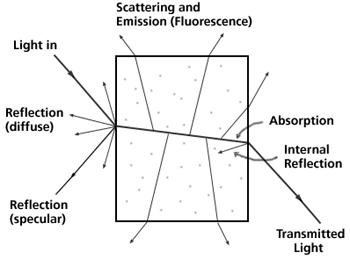

Reflection and Scattering
White clouds in a blue sky are beautiful. Why blue? Why white? To understand these colors, we first follow a beam of light which strikes a partially transparent material (Fig. 1).

Figure 1. The adventures of a beam of light passing through a block of partly transparent substance. (Taken from "The Physics and Chemistry of Color". Kurt Nassau (John Wiley & Sons, New York, 1983).)
Every time light encounters a boundary between two transparent materials with different indices of refraction some of the light is reflected (about 4% reflection at the air/glass boundary) and some is transmitted with a change in direction due to refraction (see Readings on Reflection and Refraction). If the first surface is smooth then a mirror-like or specular reflection will occur. If the surface is rough, diffuse reflection will occur. As the light penetrates into materila containing small particles, the light can be scattered by the particles or be absorbed. In the sky colors we are interested in reflection and scattering.
Blue Sky
The light in the sky is simply scattered sunlight. The scattering by small particles (in a clear sky, it is the air molecules, N2, O2, and others) is greater at the violet end of the spectrum. The color of the sky is composed of violet -- our eyes are not very sensitive to violet -- lots of blue, and decreasing amounts of green, yellow, and red. The sum appears to our eyes as "sky blue". If you observe the sky with an optical spectrometer, you note the blue sky has a broad band of colors, extending from the blue and fading toward the red.The Reading Color, Thin Films, and Interference gives more details on the origin of the blue sky. The scattering is due to particles whose size is smaller than the wavelength of the light.
White Clouds
On a normally sunny day with a blue sky, 80% of the light comes directly from the sun and only 20% from the blue sky (from M. Minnaert, "Light and Color in the Outdoors". Springer-Verlag, New York, 1993.) It is the sunlight that reflects from the clouds. The water droplets in the clouds may be many times larger than the wavelength of visible light. There are many droplets and many surfaces to reflect the light. The clouds scatter almost all the light and look white even though the clouds are nearly transparent.Beer Foam and Salt Piles
If there are many air-particle interfaces, little penetration of the light occurs and almost no color is seen. The foam on a liquid such as beer is white even though the liquid itself is colored; here, the walls of the foam bubbles are so thin that little of the light is absorbed by the liquid while reflection and scattering occur at each of the many liquid-air interfaces.
A similar argument can be made for piles of small transparent solids, such as salt, sugar, and glass.
Though the walls of the solids are not thin, there are so many particles in close proximity that the light cannot penetrate the pile without being scattered and reflected many times. The sum of all the scattered light results in a perception of a white pile, though each particle is itself transparent.
Page authored by the ACEPT W3 Group
Department of Physics and Astronomy, Arizona State University, Tempe, AZ 85287-1504
Copyright © 1995-2000 Arizona Board of Regents. All rights reserved.